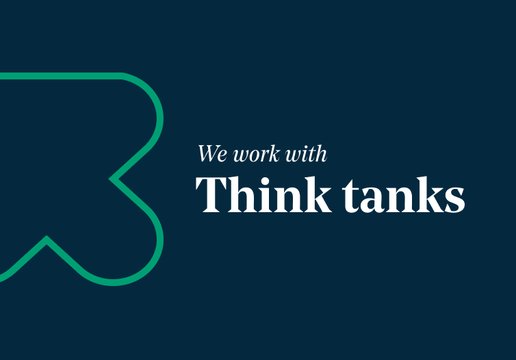TL;DR: The best think tank websites get ideas out of researchers’ heads and in front of people who need to see them – quickly, elegantly, and without a single broken plugin.
We know what you’re thinking. Well that’s very easy to say, Cursive, but we’re dealing with tens of thousands of pages, constant content turnarounds, and a CMS that feels like it was built during the Cold War.
We get it. Think tanks with good websites don’t get there by accident. Comms leads have to balance academic rigour with real-world usability. Product owners and tech directors need a platform that’s credible but never cold, structured but never suffocating. And editors just want a brain-easy content workflow that feels like writing and publishing.
So what separates the best think tank websites and platforms from those quietly gathering digital dust? We’ve spent almost 20 years partnering with research groups, nonprofits, and educational organisations to figure out exactly that. Here’s what we’ve learned.
What is a think tank website meant to do?
Think tank audiences are a wonderfully mixed bag, and your web platform needs to serve them all. You've got policymakers speed-reading on the train, academics deep-diving on citations, journalists chasing quotes, and donors looking for impact metrics.
Research from On Think Tanks (OTT) shows 70% of think tanks have made measurable policy impact in the last five years, but many struggle to communicate that impact effectively across these diverse audiences. The challenge is real: OTT found that only about one in three organisations expect sector growth in the next 12 months. Nearly half expect no change. On top of that, more than 30% of think tanks report being strongly affected by political polarisation, making it harder to build trust through online presence.
When budgets are under scrutiny, attention is fleeting, and trust takes time, your web platform is mission-critical. The solution lies in strategic clarity: knowing your purpose, audiences, and route to impact – then building digital systems that serve all three.
What do donors want to see on think tank websites?
More than 70% of think tanks identified fundraising as their biggest capacity gap, according to OTT’s 2025 report. Your web platform plays a crucial role in closing that gap. While funders gravitate toward what's visible – the glossy report, the high-profile panel, the concrete deliverables – influence also depends on what's hardest to fund: relationships, legitimacy, and long-term positioning.
Your digital platform should make all of this visible, building transparency that raises confidence, not question marks. By telling stories alongside your data, you make your mission tangible – helping donors see pathways to change, beyond individual projects and papers.
Think tanks with good websites – clearly maintained, regularly updated, accessible, and thoughtfully designed – tell donors you invest in the systems that make your research effective and sustainable. They can signal whether you have strong internal systems – governance, management, operations, and digital infrastructure – that enable impact for the long run.
The anatomy of a perfect think tank platform
The very best think tank websites and platforms share one goal: to make brilliant ideas easy to share, explore, and act on. Here’s what that looks like under the hood:
Wagtail win #74,835
Our CMS of choice is Wagtail, for many reasons. One of these is its accessibility checker, which helps reduce errors and make platforms more inclusive for all.
Design that delights, without distracting
Think tank website design can make or break mission success. It should serve as a genuine expression of your mission and values, building consistency and trust across your brand ecosystem. First, remove the mental load, looking at what your users need to do and what’s holding them back:
- Can they access research easily?
- Do digital journeys lead to dead ends?
- Is signposting clear throughout?
People visiting your site should immediately understand your mission and influence, with everything from outcomes and impact stories to partnerships and policy wins, all in plain sight:
- Is it clear what you stand for and why it matters now?
- Are you transparent about funding, governance, and data privacy?
- Can you do anything to make users feel more emotionally connected?
Whether it’s a brand-new build or rescuing an existing platform, we always start with your purpose. Then, we tailor-make clear, inclusive digital experiences that serve your think tank’s cause, support your team, and draw users in deeper. And with clear calls to action throughout your platform, you can open the door to new partnerships without feeling transactional.
Content workflows that empower editors
Beyond the front-end, what happens under the bonnet can be the difference between a seamless publishing workflow and your team losing the plot. Some content management systems can be unnecessarily complex, but they’re not all built that way. We’ve tried them all and found Wagtail (built on Django) to be the one that made sense for our think tank clients.
When you start using it, everything just clicks. Its features are satisfyingly simple: content models are thoughtfully designed, patterns (like buttons and links) are consistent, and realistic guardrails prevent broken layouts and poor performance. Editors can preview with confidence, developers can make changes without surprises, and every page adheres to design and brand standards. That’s just how it works. Comfortable and predictable, without restricting creativity.
Structure that scales with your research, not against it
When your research spans decades and disciplines, programs and policy areas, you need a site structure that grows with you – not one that buckles under its own weight. We see thoughts outgrowing their tank all the time, which is why we designed our scalable builds and proactive care services to ensure your platform can handle not just traffic, but complexity – accommodating new content, contributors, and capabilities without breaking a sweat.
Your research areas, publication types, and any cross-cutting think tank website themes should work together logically – not fight for space. Clearly structured categories make everything click, for users and editors alike.
If your audience speaks more than one language, your web platform should too. Publishing in multiple languages needn’t break your budget or require global translators – we use Wagtail’s Internationalisation feature with AWS Translate to auto-translate entire sites while keeping editorial teams in full control of any edits.
In research-driven sites, content rarely lives in isolation. A single report might belong to several programmes, reference other publications, and include datasets used elsewhere. This is also where Wagtail shines – it’s built to handle complex relationships and create interesting lateral journeys that generate curiosity, not chaos.
Editors shouldn’t need to learn code to upload a new paper. And no developer should be creating every single page from scratch. Wagtail CMS uses StreamField – basically Lego for web pages – which lets editors piece together rich, reusable content blocks (like text, images, quotes, or charts) to build pages that look neat, logical, and consistent. The platform’s Snippets features takes it further – create an author bio, related project, or key stat once, and updates sync everywhere automatically. Yes, even across hundreds of thousands of pages.
Here's a striking stat: 71% of think tanks now use AI, up from 57% in 2024. But there's a difference between adopting AI and adopting it responsibly – with intent, context, and safeguards. In our opinion, the best think tank websites from 2025 onwards will use AI to strengthen research credibility and better serve users. That means search that surfaces genuinely relevant insights, content recommendations that respect nuance, and automated accessibility features that expand reach without cutting corners. The CMS should give editors real control over where and how AI steps in – transparently flagging AI-generated content, maintaining full audit trails, and keeping human expertise firmly at the wheel.
Choosing a digital partner that truly gets think tanks
As the sector grapples with polarisation, fundraising challenges, and rapid technological change, your digital presence becomes more critical, not less. Think tanks with good websites give donors confidence, keep publishing workflows running smoothly, and protect the integrity of your research. Put simply, a well-built, well-supported platform is a sign of organisational health.
Your digital partner should understand this instinctively – without a crash course in how policy cycles work or why credibility matters more than clicks. They should know how to build for complexity, communicate with clarity, and care for your platform long after launch.
Whether you're a comms lead looking to serve multiple audiences better, a seasoned website owner planning your next iteration, or a technical director managing complex content at scale, we speak your language because we've walked your path. We know you do important work under pressure, with high stakes and limited time. So, we show up as true collaborators – tuning in, sharing the weight, and seeing the bigger picture.
We build what works, fix what doesn't, and stick around to help your think tank grow. And we're always your corner – making complex content, workflows, and integrations easy to manage, so you can focus on moving your mission forward.


